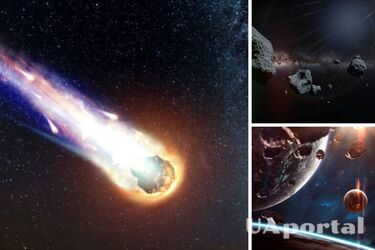World's first "boomerang meteorite" found in the Sahara Desert

Researchers speculate that an unusual stone recently discovered in North Africa may be the first known "boomerang meteorite", a space rock that originated on our planet, was thrown into space and then fell back to Earth.
However, not all scientists agree with this discovery, Live Science writes.
The meteorite, called NWA 13188 and weighing about 646 grams, was discovered by meteorite hunters in an unknown part of the Sahara Desert in Morocco in 2018. No one had seen the rock fall to Earth and its composition was found to be very similar to a certain type of volcanic rock known to scientists, leading to speculation about its origin.
A team of researchers who recently analyzed the rock now believe it is an Earth meteorite, a rock that originated on Earth and was catapulted into space millions of years ago and has just fallen back to our planet.
Read also: A woman in France fell victim to a meteorite while drinking coffee on her porch
If the team's assumption is correct, NWA 13188 will be recognized as the first official terrestrial meteorite found on Earth.
The researchers believe that NWA 13188 is a meteorite because it has a "well-developed fusion crust", a thin layer of thermal rock on its surface, which is a sign that it partially burned in Earth's atmosphere, not found in volcanic rocks on Earth.
The team also found traces of isotopes (elements with different numbers of neutrons in their nuclei), including beryllium-3, helium-10 and neon-21, suggesting that the rock was exposed to cosmic rays, high-energy particles that travel through space at nearly the speed of light. The levels of these isotopes indicate that the stone has been in space for at least 10,000 years, but possibly much longer.
There are two possible scenarios for how the meteorite was once ejected into space: the first is that a powerful volcanic eruption launched it straight into space, and the second is that it was catapulted out of the atmosphere by a colossal asteroid impact.
Researchers believe that the latter explanation is the most relevant as no recorded volcanic eruption has been powerful enough to launch rocks into space.
However, not all scientists are ready to classify the stone as a boomerang meteorite.
Read also: "It looked like a fireball": a meteorite fell between Britain and France (video)
"It's an interesting stone," said Ludovic Ferrier, curator of the meteorite collection at the Vienna Museum of Natural History in Austria. But it requires "more investigation before making extraordinary claims." Without being able to trace it back to the impact crater or knowing how old it is, it is difficult to determine exactly how the stone left or returned to Earth," the scientist added.
Others believe that the rock could also have originated elsewhere in the solar system, despite its similarities to Earth rocks. "I think there is no doubt that it is a meteorite," said Frank Brenker, a geologist at Goethe University Frankfurt in Germany.
The research team plans further analysis to determine the exact age of the rock and find any other clues that might determine how it was ejected from the Earth.
We invite you to find out what an amazing discovery archaeologists in Egypt have found and how they managed to find out that crocodiles kept their balance on the water by swallowing stones.
If you want to get the latest news about the war and events in Ukraine, subscribe to our Telegram channel!
